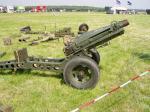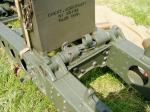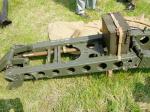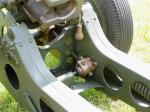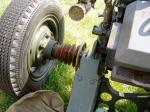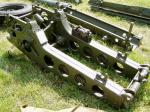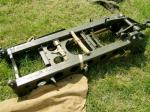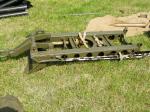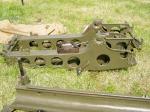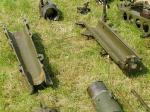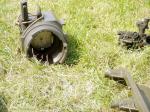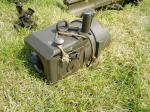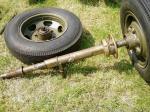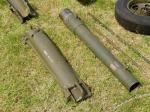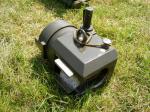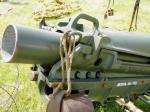75 mm M1A1 Hotwizer
English Translation
M1A1
L'obusier 75mm pack a été l'un des canons les plus polyvalents de la Seconde Guerre mondiale en plus d’être l'une des pièces d’artillerie les plus importantes de l'armée américaine
Le développement de cette arme trouve ses prémices avant la 1ère Guerre Mondiale
Le système d'arme fut un système d’arme démontable en plusieurs fardeaux facilitant le transports
Le développement de cette arme commencée en 1920 a abouti à la normalisation du M1 en 1927 pour répondre à un besoin d'une pièce d'artillerie pouvant être déplacé sur un terrain difficile. Le canon et l’affut ont été conçus de sorte qu'ils puissent être décomposés en plusieurs fardeaux pour être transportées par les bêtes de somme ou à dos d homme
 |
 |
| Internet |
Internet |
Histoire
A partir de 1920, US Army travaillé sur une pièce d'artillerie de 75 mm à traction animale, et à faible vitesse
 |
| Internet |
En août 1927, l'arme est normalisée sous le nom Howitzer, Pack, 75mm M1 avec affut de transport M1.
Des modifications mineures ont été apportées au M1 et il a ensuite été rebaptisée M1A1. Le canon était à l'origine monté sur un affut M1 a roues en bois et bandage acier. Peu avant le début de la 2e Guerre Mondiale l’affut a été remplacé par un affut type M8 conçu pour transport aérien, avec jante en acier moderne et pneumatique.
 |
| Internet |
En 1931, l'USMC a pris livraison de 4 obusiers de 75mm pack. Ces armes ont été confiées au 1e Bataillon, du 10e Marines, basé à Marine Corps Base Quantico.
Au cours des années de vache maigre de la Grande Dépression, seul un budget limité a été disponible pour les acquisitions d'armes nouvelles. Et seulement 91 pièces ont été fabriquées jusqu'en 1940, Ensuite il a été construit de Septembre 1939 à 1944
Dans les années 30, les planificateurs USMC ont imaginé la future guerre dans le Pacifique et le rôle de l’ USMC dans ce conflit.
Au centre de cette planification se trouve l'artillerie et sa place au sein des forces de débarquement Leger et maniable l'obusier joue un rôle important dans cette planification et dans son application pratique. L'obusier et son équipage avaient trois missions primaires au sein de la force débarquement.
Ils doivent;
1er réduire les défenses fortifiées ennemies,
2e neutraliser l'artillerie ennemie et de mitrailleuses,
3e Appuyer les contre-attaques.
L'obusier démontable M1A1 a été l'obusier standard pour les forces américaines durant la 2e Guerre Mondiale
La conception de cet obusier Pack trouve ses racines au cour de la 1e Guerre Mondiale ,il fut normalisé immédiatement dans l'après-guerre, dans l'armée américaine sous le nom de M1 et ensuite M116
Description
Cet obusier est l'une des armes d'artillerie les plus polyvalents de la 2e Guerre Mondiale. Il a servi sur tous les théâtres d’opération (ETO MTO PTO) Il a reçu de la part de l'USMC le surnom de Little Dynamite, en raison de sa taille et sa capacité à délivrer un volume de feu important.
 |
 |
| Internet |
Internet |
L’USMC utilise cette arme dans des conditions telles ou toute autre utilisation de canon serait tout simplement impossible
Au cours de la 2e Guerre Mondiale la fiabilité des howitzer 75 Pack M1A1 mm n’a jamais était prise en défaut . Cette arme s’est révélée extrêmement efficace et fiable
la mise à feu est manuelle, simple via un cordon.
Le canon possède un système hydropneumatique, Il est utilisé soit pour un tir direct ou indirect et peut être tirer sur des grands angles ou en feu plongeant
Il a le canon est court (tous les systèmes (ressort récupérateur t recul sont situés sous le canon) ayant une puissance de feu de 3 à 6 coups/ minute, avec un équipage entrainé
Il a une portée d'environ 8790 mètres L'obus HE du M1 pese 6,3 kg.
Cee système d'arme peut être utilisé pour la suppression, l’attaque la défense et de la lutte antichar ( limitée toutefois ).
L'obusier et l’affut peuvent également être démontés, emballés dans des paracrate
en 15 ballots distincts .L’affut M1 lui nécessite un total de 6 ballots
Tout le restant du système se démonté en neuf ballots pesant entre 73 et 107 kg chacun.
Ce dernier dispositif comprenait les 18 obus
Il a été volontairement conçu pour être léger, facilement transportable et mis en œuvre par un équipage réduit des divisions d’infanterie légères telles que les unités aéroportées)
Le Ma1A1 possède un affut M1 ou M8
L’affut M8 a été développé pour fournir aux troupes aéroportées un système d arme facilement transportable vers les zones de combat en planeur ou en avion
 |
| Internet |
Le M8 est identique au M1 la seule différence se trouve au niveau des roues.
L’affutM1 utilisé des roues en bois de 29 pouces L’affut M8 modifié pour l'utilisation motorisé possède des roues avec jante de 16 pouces équipés de pneumatiques
Il pouvait être remorqué par Jeep et transporté par avion ou en planeur, comme le Dakota C 47 et CG 4 WACO
 |
 |
| Internet |
Internet |
Versions
M1A1
M2
M3
 |
 |
| Internet |
Internet |
En plus de cette arme démontable on trouve une arme avec affut non démontable servant aussi de pièce d'artillerie de campagne
Ils étaient tous équipés de roues jante métal avec pneumatiques Ce modèle possède aussi un base rétractable . En position de tir, la base de tir pouvait être abaissée et les roues soulevées, en laissant le système reposer sur la base de tir et les flèches
Une version dérivée a été utilisée pour le M8 HMC 75mm et sur LVT.
M1A1 en action
Le M1A1 a vu l'action avec l'USMC dans MTO en ETO et PTO
Mais si l'USMC apprécie les points forts de l’arme ils reconnaissent aussi ses limites.
Notamment contre les fortifications ennemies contre lesquelles l'obusier de 105 mm est plus efficace
Toutefois cet obusier ne sera jamais remplacé et certaines divisions USMC ont toujours maintenu cet obusier en dotation tout au long de la 2e Guerre Mondiale
Il fut aussi utilisé à Arnhem avec les Britanniques, transporté en planeur durant l’ l'Opération Market Garden.
Les troupes britanniques a également formé des partisans yougoslaves de l'utilisation du système d'armes (avec un certain succès lors des combats en zone montagneuse)
 |
| Internet |
Le M1A1 75mm était employé dans divers fonctions.
Tir direct contre des objectifs tels que tanks, des bunkers, généralement dans un rayon d'action maximal de 350/650m
Lors de ce tir, le tireur s’occupe de la visée tout seul c’est la méthode one man, one sight" .
Utilisation indirecte , la section peut engager des cibles à une portée maximale d'environ 8 km.
Tir effectué généralement dans le cadre de la batterie d'artillerie, le 75 mm a été utilisé pour la neutralisation, ou de harcèlement de concentrations de troupes ennemies des positions défensives et d'autres cibles.
Des observateurs dirigent le feu et transmettent les relèves
Après la fin de la guerre, l'obusier M1A1 (M 116 après 1946) a été retiré du service en première ligne. Mais beaucoup peut encore être vu aujourd'hui comme monuments dans les parcs et comme tirant des salves d’honneur
Ce système d'arme est encore utilisé dans certains pays comme artillerie de montagne.
Versions ( Wikipedia )
• Howitzer variants:
o M1920, M1922A, M1922B, M1923B, M1923E1, M1923E2 - prototypes.[4]
o M1 - the first standardized variant. Based on M1923E2 with minor changes.[4]
o M1A1 - variant with modified breech block and breech ring.[4]
o M2 - vehicle mounted variant. Tube and breech from M1A1 were used. In order to provide a cylindrical recoil surface, the tube was fitted with an external sleeve. 197 built.[12]
o M3 - vehicle mounted variant; like M2 but with recoil surface as a part of the tube. The M2 and M3 barrels were interchangeable.[12]
o M116 - post-war designation of the complete weapon.
o M120 - post-war designation for saluting howitzers
• Carriage variants:
M1 - dismantling box trail carriage with wooden wheels
M2A1, T2, T2E1, T2E2, T2E3 - experimental carriages
M3A1 - split-trail carriage with firing base and pneumatic tires
M3A2 - M3A1 with shield added.
M3A3 - M3A2 with different wheels and combat tires.
M8 - M1 with new wheels with pneumatic tires.
Self-propelled mounts
Two nearly identical vehicle mounted variants - M2 and M3 - were developed based on tube and breech of the M1A1, for use in the 75mm Howitzer Motor Carriage T47 / M8. Both variants had a cylindlical "recoil surface" around the tube. In the M2, the surface was provided by use of a separately manufactured sleeve, while in the M3 it became an integral part of the barrel. M2 and M3 were fully interchangeable
These guns were mounted on the below armored vehicles:
• 75mm Howitzer Motor Carriage T47 / M8 - M2 / M3 in mount M7.
• LVT(A)-4 - M3 in mount M7.
• LVT(A)-5 - M3 in mount M12.
In addition, M1 / M1A1 was mated to a number of other vehicles. Only the T30 reached mass production.
• Medium Tank T5E2 - M1A1
• Experimental mount on Holt light tractor
• 75mm Howitzer Motor Carriage T1 (Tank development chassis T2).
• 75mm Howitzer Motor Carriage T3 (Combat Car M1 chassis)
• 75mm Howitzer Motor Carriage T17 (Combat Car M1E3 chassis)
• 75mm Howitzer Motor Carriage T18 (Light Tank M3 chassis) - M1A1.
• 75mm Howitzer Motor Carriage T30 - M1A1 in mount T10.
• 75mm Howitzer Motor Carriage T41 (Light Tank M5 chassis).
Caractéristiques
Poids 653 kg
Calibre 75 mm (2,95 pouce)
Equipage 6 et +
Longueur 3.68 m
Longueur du trou: 1.19 m / 15.9 calibres
Globalement 1.38 m
Largeur 1,22 m
Hauteur 0.94 m
Elévation +5 ° / 45 °
Traverse 6 °
Taux de foyer 3 / 6 tours / m
V ° initiale 381m / s
Autres Photoscopes (Others Walk Around ) 1 2 3 4
M1A1
The 75mm pack howitzer was one of the most versatile artillery weapons of the Second World War. And one of the most important gun of US Army
The development of this weapon actually traces back to before WW1
The weapon system was well know for easily to take art in a multiple pieces and light weight to carry
The development of this weapon begun in 1920 culminated in standardization of the M1 in 1927
to meet a need for an artillery piece that could be moved across difficult terrain. The gun and carriage was designed so that it could be broken down into several pieces to be carried by pack animals
 |
 |
| Internet |
Internet |
History
Beginning in 1920, the US Army worked to develop a 75mm artillery piece for pack transport, animal draft, and low-speed towing.
 |
| Internet |
In August 1927, the weapon was standardized as Howitzer, Pack, 75mm M1 on Carriage M1.
Minor changes were made to the M1 and it was subsequently redesignated as the M1A1. The piece originally was mounted on the M1 carriage, which had wood wheels and steel tires. Shortly before the start of WW2 this carriage was replaced by the M8 airborne carriage, which had modern steel rims and pneumatic tires.
 |
| Internet |
In 1931 USMC took delivery of four 75mm pack howitzers. These weapons were assigned to the First Battalion, 10th Marines, then assigned to Marine Corps Base, Quantico.
During lean years of the Great Depression, only a limited budget was available for new weapon acquisitions .Only 91 pieces were manufactured until 1940 He was built after from September 1939 to 1944
In the 30s, USMC planners conceptualized a war in the Pacific and the Corps' role in this conflict.
Central to this planning was the artillery's place in an assault landing force. As a lightweight, man-portable weapon, the pack howitzer played an important role in this thought process, and in its practical application. The howitzer and its crew had three primary missions in the landing force.
They were;
1st reducing enemy strong points,
2nd neutralizing enemy artillery and machine gun fire,
3rd stemming counterattacks.
The M1A1 Pack Howitzer was the standard howitzer for American forces in World War 2. The Pack design actually traced it's roots back to the howitzer development of World War One, standardized in the American Army post-war as the M1and after M116
Description
This howitzer was one of the most versatile artillery weapons of WW2. It served in almost every campaign (ETO MTO PTO ) He received from USMC the nickname of Little Dynamite, because of its size and ability to deliver a high volume of fire.
USMC use this weapon under conditions that made use of heavier artillery pieces either impractical, or simply impossible
During WW2 the ability of the 75 mm pack howitzer M1A1 proved its advantage , proved to be accurate effective and reliable weapon
 |
 |
| Internet |
Internet |
It is manually operated, single loaded, and uses fixed and semi fixed ammunition.
The firing mechanism is a continuous pull (self-cocking type., actuated by pulling a lanyard.
The recoil mechanism is a hydropneumatic type, having a floating piston and a pneumatic respirator. It is used for either direct or indirect fire and can be elevated to high angles to deliver plunging fire on a target.
He has short barrel, (recoil buffer and recuperator were located under the barrel ) and he could reach a sustained rate of fire of 3 to 6 rounds per minute with a capable crew, and had a range of roughly 8,790 meters The high explosive shell of the M1 Pack Howitzer weighed 6.3 kilograms.
The weapon system could be used for suppression, assault, defense and limited anti-tank duty.
The howitzer and carriage can also be disassembled , packed in paracrate loads and dropped in 15 separate loads( M1 carriage could be taken down to a total of six parts while the gun system could be taken down to nine parts with payload weight between 73 and 107 kg each .The latter arrangement included 18 rounds of ammunition) are unpacked and the howitzer and carriage are assembled for action and during action he was purposely engineered to be light, easily transportable and operated by a small crew (very well for light divisions such as airborne units )
Ma1A1 pack howitzer design can mount on the carriage M1 and M8
M8 carriage was developed to provide airborne troops with light powerful weapon easily transported as a unit to the combat area by glider or airplane
The carriage M8 is identical to the M1 carriage with the difference of the wheels .
M1 carriage used 29 inches wooden wheels . M8 modified to use steel disk and rim type wheels equipped with 16 inches pneumatic tires on metal wheels
 |
 |
 |
| Internet |
Internet |
It could also be towed by 1/4 ton jeep and transported by plane or glider such as C 47 Dakota and CG 4 WACO
 |
| Internet |
Versions
M1a1
M2
M3
 |
 |
| Internet |
Internet |
In addition to the pack / air portable version this gun was mounted on a non-dismantling carriage to serve as a field artillery piece In this version the field howitzer carriage was non-dismantling, split trail.
All these were fitted with metal wheels with pneumatic tires; all had an additional retractable support, referred to as a firing base. In firing position, the firing base could be lowered and wheels raised, leaving the weapon to rest on the firing base and trails
Derived version were used in the 75mm HMC M8 and in LVT .
M1A1 in Action
The M1A1 saw action in PTO with the USMC in MTO and in ETO
But in the PTO if USMC appreciated the strengths of the M1A1 they also recognized that the weapon had limitations. Against increasingly strong enemy fortifications, the 105mm howitzer was recognized as a weapon that had more versatility and firepower.
But the larger gun never fully replaced the pack howitzer and some Marine divisions still maintained pack howitzer battalions right up through the end of WW2
 |
| Internet |
British use them at Arnhem with the British, being dropped by glider in Operation Market Garden.
British troops also trained Yugoslavian partisans in the use of the weapon system (seeing some success in the mountain warfare role )
M1A1 75mm pack howitzer was employed by either one of two methods of fire.
It could be laid for direct firing against targets like tanks, bunkers, or pill boxes, typically out to a maximum effective range of 350/650m
In this technique of fire, the gunner centered the traversing wheel, and set the sight to the estimated range. Traversing was accomplished by moving the trail left or right to shift the entire weapon to bring it on line. This was known as "the one man, one sight" method of fire.
Using indirect lay, the section could engage targets out to a maximum range of about 8kms.
Typically firing as part of the artillery battery, the 75mm was used for neutralization, or harassing fires against troop concentrations, enemy defensive positions, and other targets. Forward observers called and adjusted fire for the battery and the fire direction center turned this information into deflection and elevation for the pieces.
There were three basic types of missions using indirect fire: grid, polar, and shift from a known point.
the M1A1 (M 116 after 1946) howitzer ‘s reputation has spare out during the war In Europe , Pacific and Far eastern countries
the system went on to see a great many years of frontline service as the standard light artillery weapon system
Finally, after the end of the war, the pack howitzer was withdrawn from frontline service. But many still can be seen today as memorials in parks and as salute guns on military bases around the country The weapon system is still used in some countries served as mountain artillery.
In the Second World War era US Army, 75 mm howitzers were issued to airborne and mountain units.
An airborne division, according to the organization of February 1944, had three 75 mm howitzer battalions - two glider field artillery battalions (two six-gun batteries each) and one parachute field artillery battalion (three four-gun batteries), in total 36 pieces per division. In December 1944, new Tables of Organization and Equipment increased the divisional firepower to 60 75 mm howitzers (as an option, in glider battalions 75 mm pieces could be replaced with more powerful 105mm M3)
The only mountain division formed, the 10th, had three 75 mm howitzer battalions, 12 pieces each. The gun was also used by some separate field artillery battalions
In the US Marine Corps, under the E-series Tables of Organization (TO) from 15 April 1943 divisional artillery included three 75 mm howitzer battalions, 12 pieces each. The F-series TO from 5 May 1944 reduced the number of 75 mm battalions to two, and the G-series TO removed them altogether, completing the shift to 105 mm and 155 mm howitzers. Although the G-series TO was only adopted on 4 September 1945, in practice in some divisions the change was introduced early in 1945.
Other operators
Two major lend lease recipients of the M1 were United Kingdom (826 pack howitzers) and China (637 pack howitzers and 125 field howitzers). 68 pieces were supplied to France and 60 to various countries in Latin America.
In the British service, the howitzer was issued to two mountain artillery regiments, two airlanding light artillery regiments, raiding support regiment and was temporary used by some other units. The gun remained in British service until late 1950s
The 75 mm howitzer was also used by Australian forces - two mountain batteries and some other units
The experience of the guns given to the army of the Republic of China was particularly notable. After the loss of the mainland, the guns were used both by the People's Liberation Army and exported to the Viet Minh. There is record of these guns being used at the Siege of Dien Bien Phu and, presumably, in later conflicts.
Variants (From Internet )
• Howitzer variants:
M1920, M1922A, M1922B, M1923B, M1923E1, M1923E2 - prototypes
M1 - the first standardized variant. Based on M1923E2 with minor changes.
M1A1 - variant with modified breech block and breech ring.[4]
M2 - vehicle mounted variant. Tube and breech from M1A1 were used. In order to provide a cylindrical recoil surface, the tube was fitted with an external sleeve. 197 built.
M3 - vehicle mounted variant; like M2 but with recoil surface as a part of the tube. The M2 and M3 barrels were interchangeableo M116 - post-war designation of the complete weapon.
M120 - post-war designation for saluting howitzers
• Carriage variants:
M1 - dismantling box trail carriage with wooden wheels
M2A1, T2, T2E1, T2E2, T2E3 - experimental carriages
M3A1 - split-trail carriage with firing base and pneumatic tires
M3A2 - M3A1 with shield added.
M3A3 - M3A2 with different wheels and combat tires.
M8 - M1 with new wheels with pneumatic tires.
Self-propelled mounts
Two nearly identical vehicle mounted variants - M2 and M3 - were developed based on tube and breech of the M1A1, for use in the 75mm Howitzer Motor Carriage T47 / M8. Both variants had a cylindlical "recoil surface" around the tube. In the M2, the surface was provided by use of a separately manufactured sleeve, while in the M3 it became an integral part of the barrel. M2 and M3 were fully interchangeable
These guns were mounted on the below armored vehicles:
• 75mm Howitzer Motor Carriage T47 / M8 - M2 / M3 in mount M7.
• LVT(A)-4 - M3 in mount M7.
• LVT(A)-5 - M3 in mount M12.
In addition, M1 / M1A1 was mated to a number of other vehicles. Only the T30 reached mass production.
• Medium Tank T5E2 - M1A1
• Experimental mount on Holt light tractor
• 75mm Howitzer Motor Carriage T1 (Tank development chassis T2).
• 75mm Howitzer Motor Carriage T3 (Combat Car M1 chassis)
• 75mm Howitzer Motor Carriage T17 (Combat Car M1E3 chassis)
• 75mm Howitzer Motor Carriage T18 (Light Tank M3 chassis) - M1A1.
• 75mm Howitzer Motor Carriage T30 - M1A1 in mount T10.
• 75mm Howitzer Motor Carriage T41 (Light Tank M5 chassis).
Ammunition
The gun fired fixed (HEAT M66) and semi-fixed ammunition, fitted with 75mm Cartridge Case M5A1 (type II) and (type I) accordingly. The propellant charge of semi-fixed ammunition consisted of base charge and three increments, forming four different charges, from 1 (the smallest) to 4 (the largest)
HEAT M66 Shell penetrated about 91 mm of homogeneous armor at 0 degrees at any range.]
Technical data
Weight 653 kg
Caliber 75mm (2.95 inch)
Crew 6and +
Length 3.68 m
Length Bore: 1.19 m / 15.9 calibers
Overall 1.38 m
Width 1.22 m
Height 0.94 m
Elevation +5°/45°
Traverse 6°
Rate of fire 3/6 rounds/m
Muzzle velocity 381m/s






